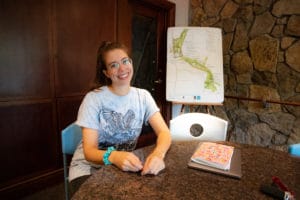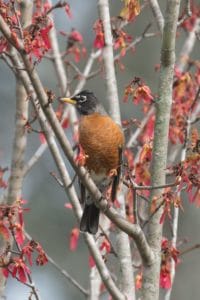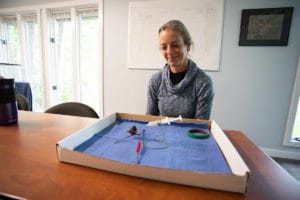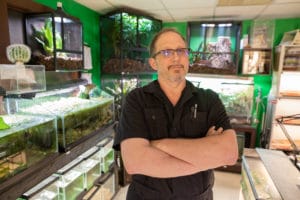Did you know that there is a nature preserve in Buckhead? One with 30 acres of nature with trails that wind along Nancy Creek through lush woodlands and wetlands, and is free and open to the public? If you have never been to the Blue Heron Nature Preserve on Roswell Road you are truly missing out.
The history of the land goes back many years to when it was the territory of Muscogee Native American tribes, often referred to by white colonizers as “Creeks” due to their tendency to build villages comprised of single-family huts around waterways. Their diet consisted of deer, small game, and fish hunted by the men while women farmed the surrounding land for squash, corn, and beans.
In 1930 sixteen Muscogee sites were identified in the area, including three in the Nancy Creek floodplan. There have been numerous arrowheads discovered along the creek at the Blue Heron Nature Preserve affirming that this area was indeed part of the Nation’s regular hunting grounds. After the forced cessation of this land to the state of Georgia in 1821, the land was then purchased for $2,750 by John W. Williams as part of a 250 acre parcel that spanned the eastern side of Roswell Road.
In the years since, development has continued to encroach upon that land, as it has all across the city, so it was gradually becoming harder and harder to find pristine natural spaces in the area. In 2000 Nancy Jones, an art teacher at Sarah Smith Elementary School, became concerned about the loss of green space in her neighborhood so she decided to do something about it. By working with the City of Atlanta and local contractors Nancy established the first 7 acres of the Blue Heron Nature Preserve at its current site along Roswell Road just across from Pike Nursery.

Over the years, Nancy grew the Preserve to what is now 30 acres which include four distinct habitats: riparian (adjacent to a river), wetlands, meadows, and woodlands. Though she retired in 2017 her reputation and impact will live on far beyond her time at the Preserve.
The Blue Heron Nature Preserve just announced that Kevin McCauley will soon be retiring from his role as Executive Director, the role to be filled by local wildlife advocate Melody Harclerode in March before the ribbon cutting of the 3-mile internal Blueway Trail during Earth Day celebrations on April 25.
“There are a lot of different ecosystems going on so a lot of different species call this place their home,” explained Miranda Swaim, Communications Director of the Blue Heron Nature Preserve.

The sprawling land and accompanying wetlands represent a crucial part of the local ecosystem in an area that is increasingly dense with homes, businesses, and roads. Just how many species benefit from this land, you wonder? “Thousands,” Miranda said with a chuckle. ”That’s counting all the different plants, flora, fauna, and animals. There are so many different types of species that you’ll see seasonally and year round, and then of course all the different animals that live here.”
Because the land is a floodplain the topography of the Preserve is in a state of constant flux. The sandy shores ebb and flow, the marshlands grow deeper and shallower depending on the rainfall, and the wooden boardwalks throughout are constructed on specially designed concrete sleepers that enable the walkways to float when water levels get too high.
The Blue Heron Nature Preserve is a 501(c)3 nonprofit whose mission is to “create a personal experience with nature through conservation, education, research, and advocacy.” They accomplish these broad goals by tracking and researching native wildlife, bringing in visitors to the park through the arts, and educating the public through classes and special events.
“We like to tie all of these together – because they do have a synergetic relationship – to enhance the green space we have here.”
Bringing the arts out into nature, and also bringing nature into the arts, has been a major boon to the work achieved at the Preserve. Led by Art Director Sally Eppstein whose monumental feather and totem welcome you from the main road, the Preserve features artists-in-residence as well as an annual six week outdoor installation called the Art of Nature during which time pieces are displayed throughout the grounds. The works are subjected to the brutal realities of exposure to the elements, providing an often fascinating evolution from studio to degradation.
It’s not only the arts and events hosted by the Preserve itself that bring crowds to experience the land, however. There are two other key conservation organizations that call the Blue Heron Nature Preserve home: the Atlanta Audubon Society and the Amphibian Foundation.
I met with Adam Betuel, Director of Conservation, and Melanie Furr, Director of Education, in a bright conference room on the second floor of the Blue Heron Nature Preserve’s central building. A small hummingbird missing its tail feathers sat peacefully on a flat display in the middle of the table between us, occasionally making curious chirping sounds and fluttering its wings, the vibrant colors of its feathers catching the light as it peered around the room.

“I would say that we build places where both birds and people thrive,” explained Adam. “We do that through education, conservation, and advocacy. That’s kind of our broad mission.”
A bird lover since he was in high school, Adam has made a career out of researching and educating others on ornithology, the scientific study of birds. “People aren’t going to know about our birds and care about our birds if they don’t even know that they are out there or the amazing things that they do for us and for our ecosystems.” Adam’s job at the Audubon Society is to unite the worlds of field research with programs that aim to reduce the risks to bird populations across the Southeast.
A large part of Adam’s advocacy is aimed at encouraging homeowners and developers to implement solutions to reduce the amount of deaths incurred by light pollution and window collisions. “Bird window collisions are the third biggest cause of bird death in our country, behind outdoor cats and habitat loss,” said Adam. “Between 365 million and 1 billion birds annually die from hitting buildings.”

While anyone could imagine the negative impact of razing a forest to make way for a parking garage or high-rise, it’s also important to understand the manner in which birds navigate through the area and how collisions with buildings can impact bird populations.
Relying upon stars and the sun for direction, light pollution at night can throw whole flocks of passing birds off track. Beyond that, glassy windows and shiny structures both big and small have a tendency to confuse passing birds who mistake a reflection for another tree or a clear flight path. Just a few months ago an incident wherein hundreds of chimney swifts collided with the NASCAR Hall of Fame in Charlotte, N.C. brought nationwide awareness to this issue.
Though ideally developers and builders would consider these risks to native birds and build with materials designed to reduce these risks, the fact is that many do not and those life-saving measures can be cost prohibitive. That’s why Adam recommends utilizing special tape and films on existing windows to prevent birds from seeing the panes as a viable flight option.

Sibley, the tailless hummingbird ambassador who graced us with a dazzling feather display during the interview, was also a victim of a window collision. As a result he is now flightless and would have no chance of survival in the wild were it not for the rehabilitation efforts and care given to him by Melanie Furr.
I learned from Melanie that hummingbirds are the most common victims of window collisions in Atlanta out of the hundreds of species that suffer from these injuries every year. Atlanta is considered the 9th worst city for window collisions in the spring and the 4th worst in the fall due to light pollution and structural developments.

A former English teacher, Melanie has united her love of birds with a knack for education in her role at the Audubon Society. She teaches everyone aged “three to 103” about birds, why they are so important, and how to look out for them. While her methods vary depending on the audience, a big part of what she accomplishes is to eradicate something called “bird blindness,” a term that describes the uncanny way in which humans tend to overlook birds even as they flit about in front of their very eyes.
Indeed, birds are all around us. From common backyard species such as chickadees, cardinals, finches, and sparrows to waterfowl and birds of prey like bald eagles, vultures, and osprey, these feathered friends deserve our appreciation and protection as our desire for expansion threatens their survival.
Not only do birds eat many of the bugs and pests that we dislike, they also pollinate our crops and play an important role in the food chain for larger predators. We can help them by taking actions to reduce collisions, keeping cats indoors, and planting native species in our yards to provide them with much needed nutrients.
Down the hall and through a doorway is a separate wing of the Preserve’s central building: the Amphibian Foundation’s headquarters. Here, in tanks and cases, are more than 1000 amphibians of all colors, shapes, and sizes. Founded by Mark Mandica and his wife Crystal, the Foundation is doing a critical service to the local ecology by studying, conserving, and preserving a vast array of these unique creatures.
A lifelong lover of amphibians, Mark has made it his life’s work to preserve these species and provide opportunities to educate the public about them. “I’ve been focusing on amphibians for a number of years and I noticed that they are disappearing from my study sites,” said Mark who noticed a sharp decline in native species over the past 20+ years of study.

“I was doing more laboratory work and now I’m doing more conservation work because they are disappearing and I feel like it’s an all-hands-on-deck situation,” said Mark.
The species housed at the Amphibian Foundation include frogs, snakes, salamanders, turtles, and a number of odd and off-beat amphibians that you may very well have never heard of before. In his office, surrounded by walls of glowing aquariums that bubble and ripple with the movement of the tiny creatures inside, we sat to talk about the importance of these animals to the environment and how he aims to help them.
On the table in front of us a lungfish – technically a fish though it does breathe air and has feet instead of gills – undulates in a small fishbowl, occasionally punctuating our conversation by bumping into the glass.
“They are fascinating to me,” continued Mark, noting that there are over 7,000 distinct species of amphibians in existence, and metro Atlanta is home to 28 of them.
“Basically every setting or environment has amphibians uniquely adapted for it,” explained Mark. “Most people aren’t aware but there were frogs hopping around the feet of the dinosaurs, there were some really big ones that used to eat baby dinosaurs. They were a foot or two tall and were ferocious, they still are but they are ferocious to bugs and stuff now,” he said with a chuckle.
What began as a few tanks in their basement has expanded to a massive undertaking at the Blue Heron Nature Preserve that employs 2 part time employees and around 80 volunteers.
Because amphibians are “sensitive” as Mark puts it, the onset of habitat loss, climate change, and introduction of diseases has decimated many of these creatures. Their territories are affected by new buildings that displace local streams and change the ecology of an area, fracturing populations into smaller and smaller territories and oftentimes keeping them from crucial access to water and food sources. Even something as benign as clearcutting a path through a forest to install a power line has shown to have negative effects on these small creatures as they instinctively do not pass through open spaces for fear of attacks from predators.

Mark explained that not only are amphibians so important to the environment due to their capacity to eat insects – 1000 frogs can eat 5 million bugs in one year – but also because they serve as a kind of canary in the coal mine for climate change.
“Once they are gone a lot is going to fall,” warned Mark. “Everything that eats amphibians, they are going to disappear, everything that amphibians eat is going to increase, it’s just going to be crazy. Meanwhile they are clearly showing us that our ecosystems are out of balance.”
Not only do amphibians suffer from habitat loss and the prevalence of outdoor cats as native birds do, amphibians also typically incur feelings of apathy, aversion, or even downright animosity from all those who encounter them. Many who are unfamiliar with snakes automatically assume that all are venomous and must be killed, or if they see a salamander or lizard they simply want to remove it from their property and don’t stop to consider the important role they play in the local ecosystem.
The classes at the Amphibian Foundation offer a unique insight into the wild and weird world of amphibians. Kids who attend the summer camp programs start off with frogs and learn about a number of different species before ending the week with snakes. They learn about their anatomy, their habits and diets, and become advocates for these tiny creatures in a way that enables them to better understand and appreciate their needs.
Amphibians and birds, though vastly different in many ways, have several common enemies. Of course habitat loss is a big one, but they are also victims of outdoor cats and pesticides. Outdoor and feral cats kill around 3.7 billion birds and between 95 to 299 million amphibians each year. Meanwhile the pest control and lawn treatments that we spray so liberally in the air and on our plants have a massive ripple effect, poisoning whole ecosystems from the insects all the way up to prey animals. The impact of these dangers really cannot be overstated, and if we want to help our local ecology we must learn about and make efforts to reduce risks to even the smallest of these native creatures.
So before you go out and buy that weed killer, install a wall of shiny glass windows along the side of your house, or let your feline friends roam outside, stop to consider the impact your actions have on the local ecology. You can learn a lot by attending a class at the Amphibian Foundation, visiting the Preserve for a “forest bathing” meditative walk, or tagging along on a bird-watching walk with the Atlanta Audubon Society. Advocacy and understanding will go a long way in helping to ensure these critters stick around and continue to thrive for generations to come.